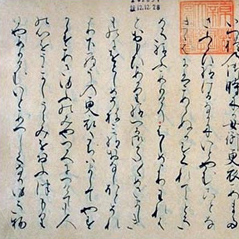|
Heiho Okugi Sho: Samurai Endeavors
|
Fujiyama Dojo P.O. Box 20003 Thorold, ON, Canada L2V 5B3 (905) 680-6389 |
|---|
 Documents about samurai strategy have been handed down through many generations, sometimes within one family and sometimes they have been made accessible to the general public and are now treated as classic literature.
The better known records of the "old ways" of the history of Japan are literary pieces, such as the Kojiki (record of ancient matters) which dates from 712 A.D.; Genji Monogatari (Tales of Genji) from the 11th century manuscript seen to the right; and the Heiki Monogatari (Tales of the Heike) which tells us about the power struggle between the Taira clan (Heike) and the Minamoto clan (Genji) during the later years of the 12th century.
However, it is in the military manuals that we find the true character of Bushido and begin to understand how the Warrior developed from a spear yielding man who moved forward on command, to a minute tactician who took into consideration all the factors of battle, including human nature, and backed it up with a philosophy that enabled him to see war as an art, and which also served as a code of ethics.
Today, some of these documents are the legacy of the warriors of the past and a testament to their talents and ingenuity as well as their courage.
Heiho Okugi Sho was written by Kansuke Yamamoto, a Kyoto general and senior military strategist to the Takeda clan. His manual dates back to the 16th century and describes some of the secret military strategies of the Takeda clan. The Heiho Okugi Sho makes for fascinating reading material for a Budo and Bujutsu student because of the similarities in views to the better-known traditional martial arts of today in matters of initiative, timing and movement.
The document known in the West as Troop Management, by Shingen Takeda is among the most valuable from an historical point of view. The mottoes of Shingen Takeda (Fu Rin Ka Zan) were:
Quick as the wind. Documents about samurai strategy have been handed down through many generations, sometimes within one family and sometimes they have been made accessible to the general public and are now treated as classic literature.
The better known records of the "old ways" of the history of Japan are literary pieces, such as the Kojiki (record of ancient matters) which dates from 712 A.D.; Genji Monogatari (Tales of Genji) from the 11th century manuscript seen to the right; and the Heiki Monogatari (Tales of the Heike) which tells us about the power struggle between the Taira clan (Heike) and the Minamoto clan (Genji) during the later years of the 12th century.
However, it is in the military manuals that we find the true character of Bushido and begin to understand how the Warrior developed from a spear yielding man who moved forward on command, to a minute tactician who took into consideration all the factors of battle, including human nature, and backed it up with a philosophy that enabled him to see war as an art, and which also served as a code of ethics.
Today, some of these documents are the legacy of the warriors of the past and a testament to their talents and ingenuity as well as their courage.
Heiho Okugi Sho was written by Kansuke Yamamoto, a Kyoto general and senior military strategist to the Takeda clan. His manual dates back to the 16th century and describes some of the secret military strategies of the Takeda clan. The Heiho Okugi Sho makes for fascinating reading material for a Budo and Bujutsu student because of the similarities in views to the better-known traditional martial arts of today in matters of initiative, timing and movement.
The document known in the West as Troop Management, by Shingen Takeda is among the most valuable from an historical point of view. The mottoes of Shingen Takeda (Fu Rin Ka Zan) were:
Quick as the wind.
Still as a forest. Conquer like fire. Immovable as a mountain. All of these are implicit in his writings. For some, those military manuals are more revealing about the history of Japan than any other document ever handed down to current days. These Bushido codes, books of strategy and management, training scrolls etc. offer an insight of a different nature into the life and mentality of the old warrior. Although some might find them too "cut and dried", to a great extent they relate the hard truth. The poetry in the lives of the ancient samurai went as far as the blade permitted, and perhaps for that matter, was all the more appreciated. Dr. K. Yamashiro wrote, "The true samurai never complained about his life, but accepted his path with pride more than resignation. He [Samurai] was never good as a crying shoulder for anyone, nor did he ask for one. His philosophy, in today's words, was: 'Do or die'. In a world that is plagued by excuses, such as the one in which we live, he saw things in black and white, without shades of grey. This attitude inspires the admiration of the strong and the resentment, criticism and hate of the weak." Strategy was a way of life, more than just a skill, and the documents which have survived until today show us a glimpse into that nature. Critics abound; skeptics belch their words in contemporary cynicism, but neither group can take away from such legacy. Because the samurai knew how to die, the martial artist of today knows how to live. The treasure of thought and action left in those documents deserve, at the very least, one careful look from those who wish to understand Budo. |
|---|


